Just as a garden breathes life into outdoor spaces, your kitchen can transform into a vibrant oasis with strategically placed plants. You’ll discover nine innovative ways to incorporate greenery that serves both form and function, from space-saving vertical herb gardens to low-maintenance succulents. Whether you’re working with a sunny windowsill or a dimly lit corner, these plant ideas will enhance your cooking space while providing fresh ingredients and improved air quality.
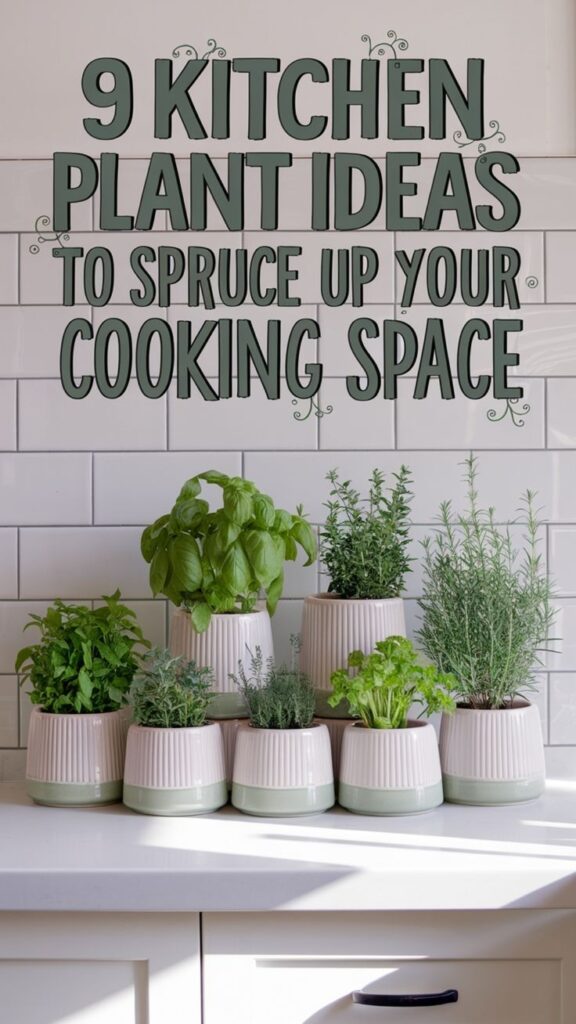
Contents
- 1 Fresh Herbs on a Sunny Windowsill
- 2 Space-Saving Vertical Herb Garden
- 3 Low-Light Plants for Dark Corners
- 4 Air-Purifying Plants for Better Kitchen Air Quality
- 5 Hanging Plants for Small Kitchen Spaces
- 6 Succulent Arrangements for Kitchen Countertops
- 7 Edible Microgreens for Year-Round Harvesting
- 8 Pet-Safe Plants for Family Kitchens
- 9 Water-Wise Plants for Busy Cooks
Fresh Herbs on a Sunny Windowsill
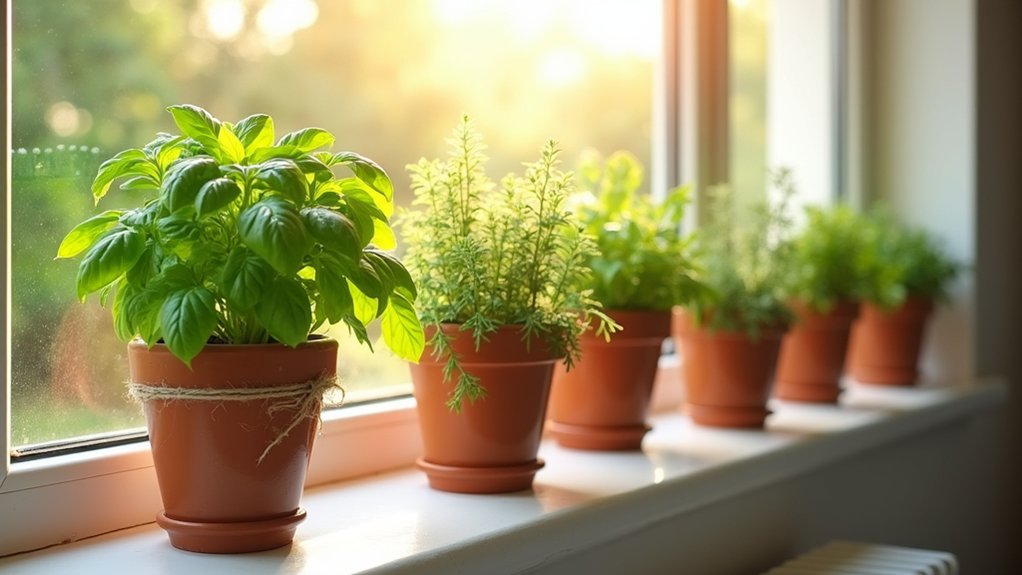
Growing fresh herbs on a sunny windowsill creates a functional and aromatic mini garden that brings life to any kitchen space. Common windowsill herbs like basil, thyme, mint, and parsley add vibrant greenery while providing fresh ingredients within arm’s reach of food preparation areas.
These compact plants typically grow in small containers lined along the window, creating a living display that combines practicality with natural beauty.
- Light: 6-8 hours of direct sunlight daily, preferably from a south-facing window
- Water: Soil should remain consistently moist but not waterlogged
- Soil: Well-draining potting mix specifically formulated for herbs
- Temperature: 65-70°F (18-21°C)
- Container: Pots with drainage holes, 6-8 inches deep
- Spacing: 6-12 inches between plants, depending on herb variety
- Humidity: Moderate, can benefit from occasional misting
Regular harvesting promotes bushier growth and prevents herbs from becoming leggy or flowering prematurely.
Rotate containers weekly to ensure even growth, and fertilize monthly with a balanced, water-soluble fertilizer during the growing season.
Remove any yellowing or dead leaves promptly, and periodically check for pests like aphids or spider mites, especially in the warm, indoor environment.
Space-Saving Vertical Herb Garden
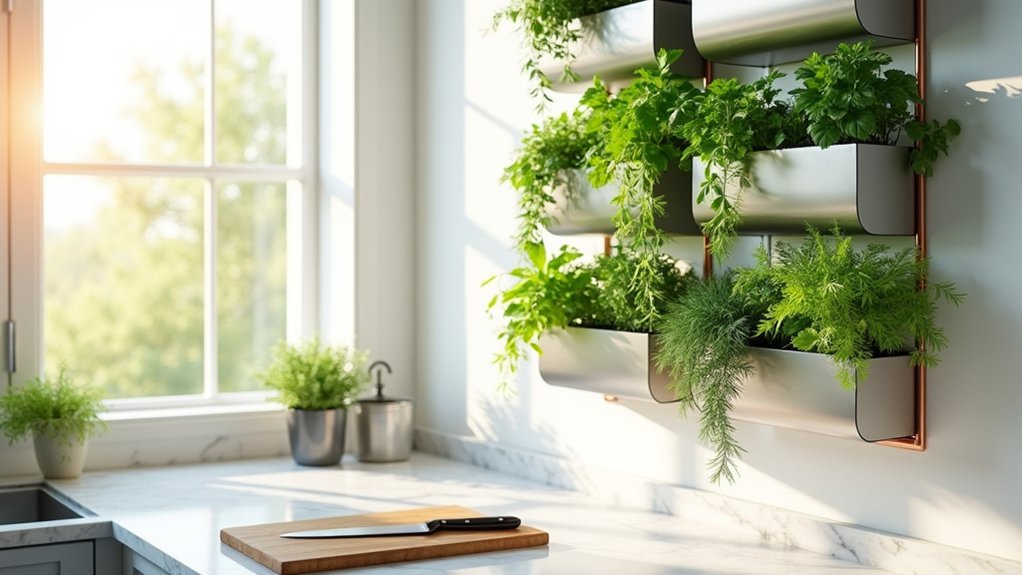
A vertical herb garden transforms unused wall space into a functional and aesthetically pleasing growing area, perfect for compact kitchens. These gardens typically feature tiered planters, pocket organizers, or mounted containers arranged vertically, allowing multiple herbs to grow within arm’s reach of food preparation areas.
Modern designs may incorporate self-watering systems, while rustic versions might utilize repurposed materials like wooden pallets or mason jars mounted on boards.
- Light: Minimum 6 hours of direct sunlight daily; south or west-facing walls ideal
- Water: Consistent moisture without waterlogging; check soil daily as vertical gardens dry faster
- Soil: Well-draining potting mix enriched with organic matter
- Temperature: 65-70°F (18-21°C)
- Spacing: 4-6 inches between plants, depending on herb variety
- Container depth: Minimum 6 inches for most kitchen herbs
Regular pruning encourages bushier growth and prevents herbs from becoming leggy or overwhelming their designated spaces.
Rotate containers periodically to ensure even growth, as plants may lean toward light sources. Monitor for signs of nutrient deficiency, as vertical gardens can quickly deplete soil resources, and fertilize with a balanced, water-soluble fertilizer every 4-6 weeks during the growing season.
Remove any yellowed or damaged foliage promptly to maintain air circulation and prevent disease spread.
Low-Light Plants for Dark Corners
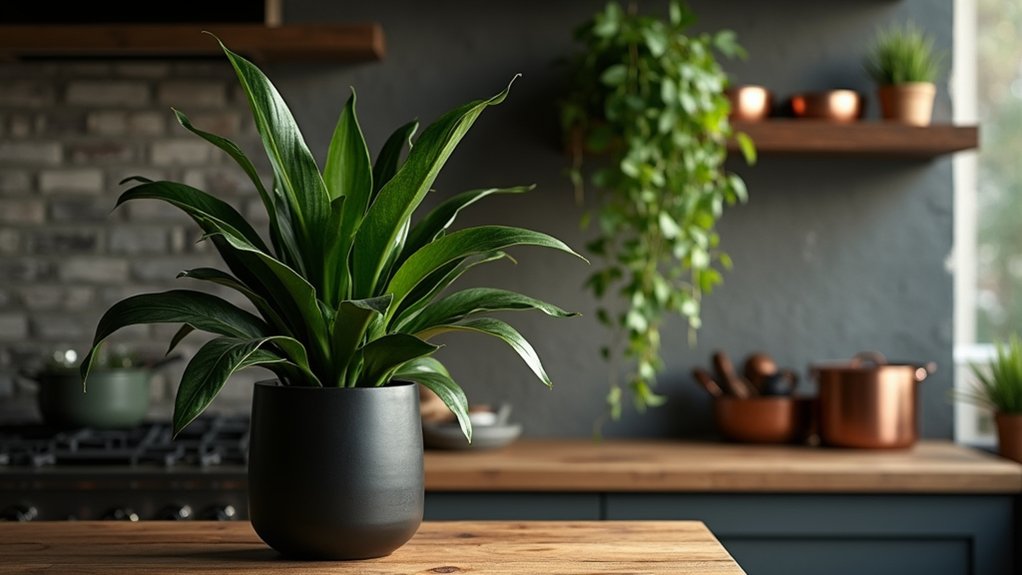
Low-light plants are resilient indoor species specially adapted to thrive in darker areas of the kitchen where natural sunlight is limited. These plants typically feature broad, dark green leaves that efficiently capture and utilize minimal light for photosynthesis. Common varieties include snake plants, ZZ plants, pothos, and Chinese evergreens, which not only survive but can flourish in shadier spots while adding natural beauty to underutilized kitchen spaces.
- Light: Tolerates low to moderate indirect light; avoid direct sunlight
- Water: Allow top 1-2 inches of soil to dry between waterings
- Soil: Well-draining potting mix with good aeration
- Temperature: 60-75°F (15-24°C)
- Humidity: Average household humidity (40-50%)
- Fertilizer: Light feeding every 2-3 months during growing season
Regular dusting of leaves with a damp cloth helps maximize light absorption in low-light conditions. Rotate plants quarterly to ensure even growth, and trim any yellow or brown leaves promptly to maintain plant health.
While these plants are generally slow-growing in low light, avoid the temptation to overwater or over-fertilize, as this can lead to root rot and other problems. Monitor for signs of insufficient light, such as leggy growth or pale leaves, and adjust placement if necessary.
Air-Purifying Plants for Better Kitchen Air Quality
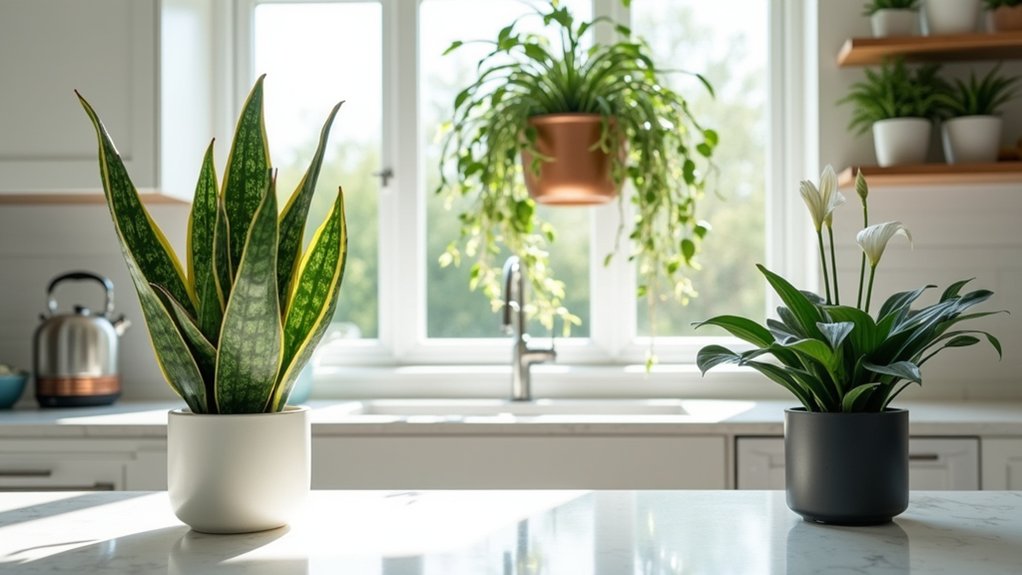
Air-purifying plants in the kitchen serve the dual purpose of adding natural beauty while actively removing common indoor pollutants, cooking odors, and harmful chemicals from the air. Popular choices include the snake plant (Sansevieria), spider plant (Chlorophytum comosum), and peace lily (Spathiphyllum), which are particularly effective at filtering volatile organic compounds often found in kitchen environments.
These plants range from upright, architectural specimens to cascading varieties that can be displayed on countertops, windowsills, or hung from ceiling hooks.
Growing Conditions:
- Light: Most air-purifying plants tolerate moderate to bright indirect light
- Water: Allow top inch of soil to dry between waterings
- Soil: Well-draining potting mix with good aeration
- Temperature: 65-80°F (18-27°C)
- Humidity: Average household humidity (40-60%)
- Container: Pots with drainage holes to prevent root rot
Regular dusting of leaves with a damp cloth maintains the plants’ air-purifying efficiency by keeping pores unclogged.
Rotate containers quarterly to ensure even growth, and inspect leaves monthly for signs of pests or disease. Remove yellow or dead foliage promptly to prevent fungal issues, and avoid placing plants near direct heat sources or cold drafts, which can stress the plants and reduce their air-cleaning capabilities.
Hanging Plants for Small Kitchen Spaces
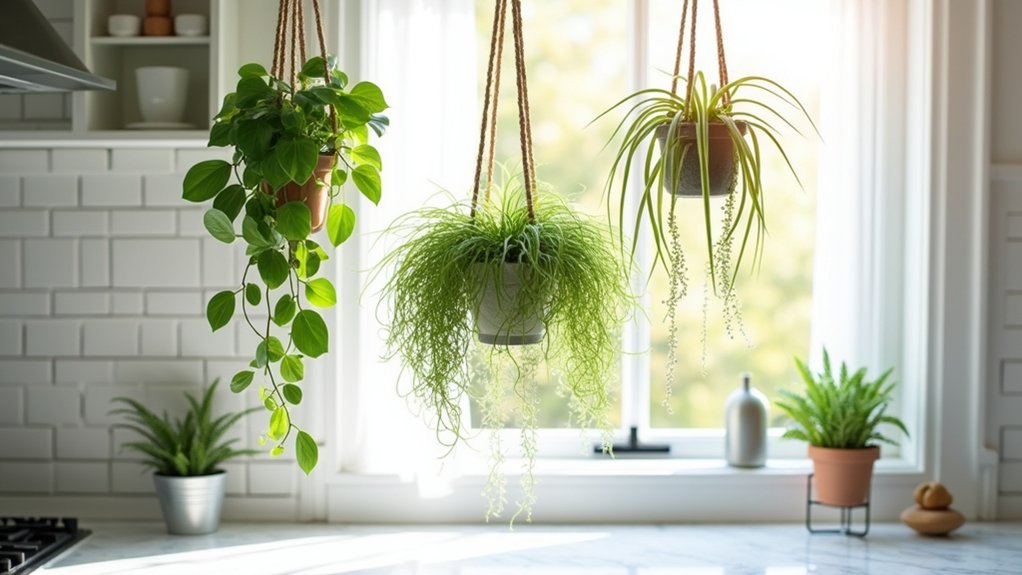
Hanging plants offer an innovative solution for maximizing limited kitchen space while adding natural beauty to the room. These suspended gardens can transform unused vertical spaces above counters, in corners, or near windows into vibrant displays of cascading foliage.
Popular choices like pothos, spider plants, and string of pearls create dramatic curtains of greenery that soften the kitchen’s hard surfaces without taking up valuable counter space.
- Light: Bright, indirect light; avoid direct afternoon sun that can scorch leaves
- Water: Allow top inch of soil to dry between waterings; reduce frequency in winter
- Soil: Well-draining potting mix with added perlite
- Temperature: 65-80°F (18-27°C)
- Humidity: Moderate to high; benefits from kitchen’s natural humidity
- Container: Lightweight pots with proper drainage holes
- Mounting: Secure hooks or brackets rated for plant and pot weight
Regular maintenance keeps hanging kitchen plants healthy and prevents mess in food preparation areas. Trim yellowing or dead foliage promptly, rotate plants quarterly for even growth, and dust leaves monthly with a damp cloth to maintain their ability to photosynthesize efficiently.
Check hanging hardware monthly for security, and consider using drip trays or self-watering systems to prevent water spillage on kitchen surfaces below.
Succulent Arrangements for Kitchen Countertops
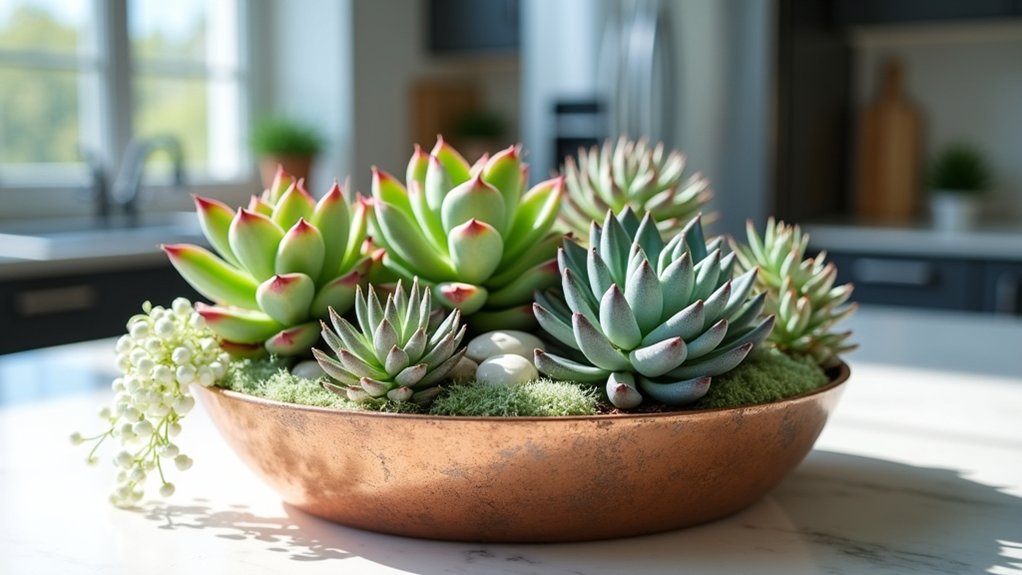
Succulent arrangements for kitchen countertops create charming, low-maintenance focal points that combine different shapes, sizes, and colors of drought-resistant plants.
These versatile displays can feature rosette-forming echeverias, trailing string-of-pearls, spiky haworthias, and plump jade plants arranged in shallow containers or creative vessels like teacups, mason jars, or vintage kitchenware, adding a modern yet organic touch to kitchen decor.
Growing Conditions:
- Bright, indirect sunlight – at least 6 hours daily
- Well-draining cactus or succulent potting mix
- Containers with drainage holes
- Room temperature between 60-80°F (15-27°C)
- Low humidity environment
- Water only when soil is completely dry (typically every 7-14 days)
Regular maintenance of kitchen succulent arrangements involves removing dead leaves, rotating containers quarterly for even growth, and watching for signs of stretching or color changes that indicate lighting issues.
Dust leaves gently with a small brush, and trim leggy growth to maintain compact shapes. During winter, reduce watering frequency by half and move arrangements away from cold windowsills or drafty areas to prevent damage.
When repotting becomes necessary (usually every 2-3 years), choose containers just slightly larger than the current ones to prevent overwatering issues.
Edible Microgreens for Year-Round Harvesting
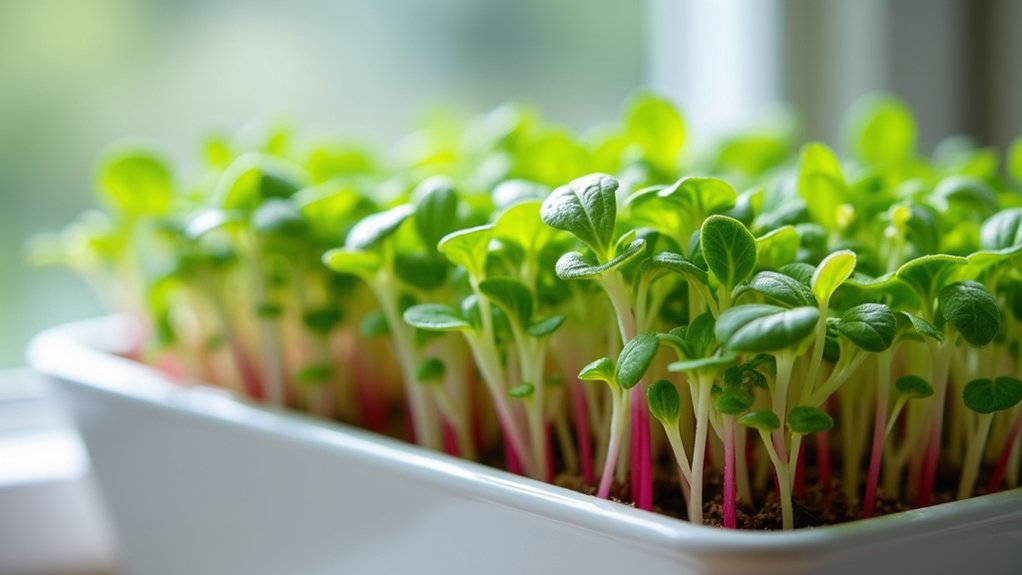
Microgreens are miniature edible plants harvested at their first true leaf stage, typically 1-3 inches tall, offering concentrated nutrients and intense flavors compared to their full-grown counterparts. These tiny powerhouses include varieties like radish, mustard, basil, and sunflower shoots, providing fresh garnishes and nutritious additions to meals throughout the year, even in limited kitchen spaces.
Their delicate appearance and vibrant colors make them both decorative and practical for indoor cultivation.
- Light requirements: 4-6 hours of direct sunlight daily or 12-16 hours under grow lights
- Water needs: Consistent moisture without saturation; bottom watering preferred
- Growing medium: Sterile, fine-textured potting mix or specialized microgreen soil
- Temperature range: 65-75°F (18-24°C)
- Container depth: 1-2 inches with drainage holes
- Humidity: Moderate, around 50%
- Air circulation: Good ventilation to prevent mold
Success with microgreens requires regular monitoring and careful harvesting techniques. Cut the stems just above soil level with clean, sharp scissors when the first true leaves develop, typically 7-21 days after sowing.
Practice succession planting by starting new trays every week for continuous harvests, and maintain strict cleanliness to prevent mold growth. Remove any yellowing plants promptly, and avoid overseeding to prevent overcrowding, which can lead to poor air circulation and disease issues.
Pet-Safe Plants for Family Kitchens
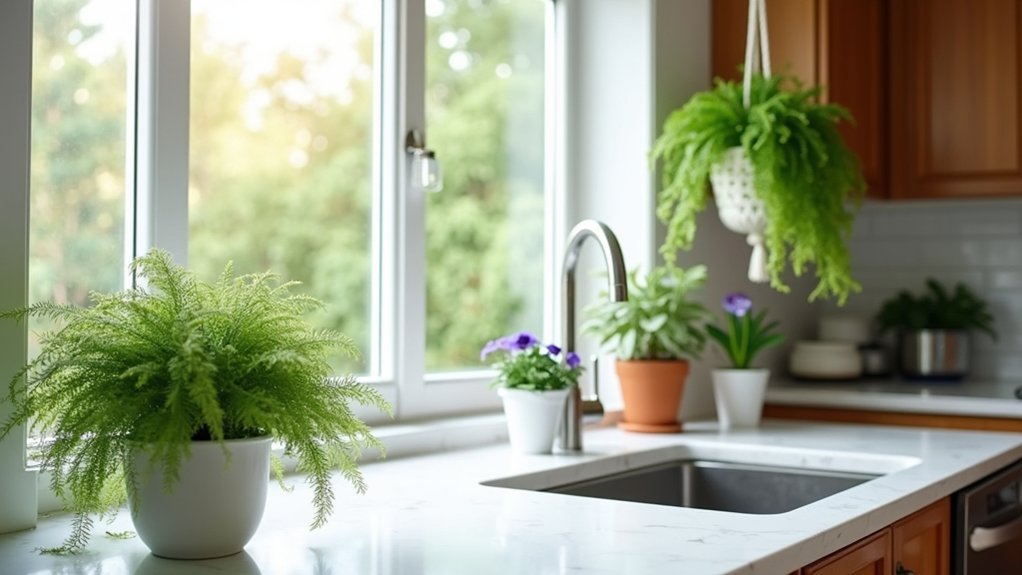
Pet-safe kitchen plants offer peace of mind for households with furry friends while adding natural beauty to the cooking space. Popular non-toxic options include spider plants with their arching variegated leaves, sturdy Boston ferns with their lush fronds, and compact African violets that produce colorful blooms.
These plants have been thoroughly vetted by veterinary experts and are safe if accidentally ingested by cats or dogs, making them ideal choices for family kitchens where pets may explore or nibble on greenery.
Growing Conditions:
- Bright, indirect light for most pet-safe varieties
- Moderate temperatures between 65-75°F (18-24°C)
- Well-draining potting soil with good aeration
- Regular watering when top inch of soil feels dry
- Humidity levels around 50-60%
- Monthly feeding with diluted, pet-safe fertilizer during growing season
Regular grooming and inspection help maintain healthy pet-safe kitchen plants. Remove any yellowed or damaged leaves promptly to prevent disease spread and maintain appearance.
Rotate plants quarterly to ensure even growth, and clean leaves monthly with a damp cloth to remove dust that can inhibit photosynthesis.
Consider placing plants in elevated locations or hanging baskets to create an additional barrier between curious pets while still maintaining the plants’ decorative appeal in the kitchen space.
Water-Wise Plants for Busy Cooks
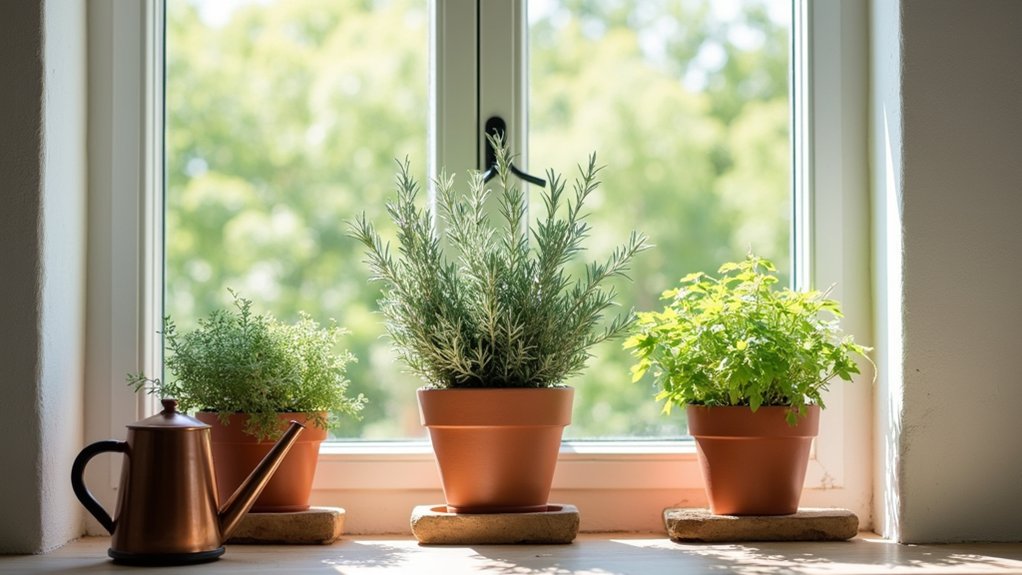
Water-wise plants for busy cooks combine practicality with sustainability, featuring drought-resistant herbs and edible plants that can thrive with minimal attention. These hardy varieties, such as rosemary, thyme, sage, and succulents, typically have thick, waxy leaves or needle-like foliage that helps them retain moisture. Their compact growth habits and architectural forms make them attractive additions to kitchen windowsills and countertops while providing fresh flavors for cooking.
- Light: Most water-wise kitchen plants need 6-8 hours of bright, direct sunlight daily
- Water: Allow soil to dry between waterings; water deeply but infrequently
- Soil: Well-draining potting mix with added perlite or sand
- Temperature: Prefer warm conditions between 65-80°F (18-27°C)
- Container: Terracotta or unglazed clay pots with drainage holes
- Spacing: Plant individually or group similar species with 4-6 inches between each
Regular pruning and harvesting encourage bushier growth and prevent these plants from becoming woody or leggy. Remove any yellowed or dead foliage promptly to maintain plant health and appearance.
Apply a light feeding of balanced organic fertilizer every two months during the growing season, and rotate containers quarterly to ensure even growth. Inspect leaves regularly for pests, particularly spider mites and scale insects, which are attracted to dry conditions.
